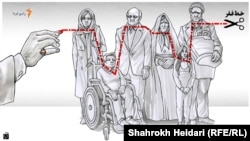“Resistance economy” has re-emerged in Iranian official rhetoric following the wave of unrest that swept the country in late December 2017 and early January this year.
Iranian military and security officials, as well as members of the country’s religious bureaucracy, have attempted to portray the protests as being solely a reaction to the country’s economic problems rather than an expression of dissatisfaction with the regime itself.
These same officials have responded to the unrest by blaming Iran’s economic problems on the policies of President Hassan Rouhani’s administration, which they accuse of neglecting the principles of “resistance economy,” a concept introduced by Iran’s Supreme Leader Ayatollah Ali Khamenei in 2011 in response to Western sanctions.
Khamenei’s resistance economy is a broad policy of resisting the economic pressure of sanctions by creating domestic versions of foreign products, increasing barter trade, and in some cases circumventing sanctions altogether with smuggling. He described it at the time as “an economy that can bring about growth and flourishing under pressure while the people have to face sanctions and hostility.”
None of the financial advantages the regime grants to the elite was affected by the sanctions. Embezzlement and financial corruption continued. Lofty loans were given out of the nation’s pocket to regime insiders at extremely low interest rates. Petro dollars poured into government-funded religious institutions.
The Supreme Leader’s allies say resistance economy is the only way to solve the country’s economic problems, but what do Khamenei and his men mean by “resistance economy?” And can it address Iranians’ demands?
Lowering Expectations
The idea of resistance economy is not about economic policy. If it was, it would be discussed and promoted by economists, not the military or clerics. Talking about resistance economy is part of the government’s social and cultural engineering.
The most significant economic aspect of resistance economy is the policy of habituating Iranians to poverty by convincing them their plight is caused by “foreign enemies.” Unfortunately for the government, Iranians have not grown accustomed to their low living standards.
Many Iranians live on the bare minimum while their rulers live lavishly and fund the apparatus for suppressing the nation at home and intervening in the domestic affairs of other countries. Khamenei suggests that “the nation should consume less” while the government wastes the country’s resources, bringing tensions to a head.
The government’s main problems are the people’s demands and expectations. They want Iranians to be satisfied with the standard of living the government has defined for them rather than demanding better.
Accepting the ruling elite’s advantages
None of the financial advantages the regime grants to the elite was affected by the sanctions. Embezzlement and financial corruption continued. Lofty loans were given out of the nation’s pocket to regime insiders at extremely low interest rates. Petro dollars poured into government-funded religious institutions.
On the other hand, nothing was done to improve housing, education, public health, or transportation for the nation after the nuclear deal with the West.
Economic seclusion
Those who defend the concept of resistance economy warn against improved ties with the outside world. They are against making the Iranian economy part of the world economy.
Economic transparency is another element discussed in Khamenei’s definition of resistance economy, but none of the institutions under his supervision have ever published any financial records.
Khamenei, as the man who introduced the concept of resistance economy, has several institutions under his supervision. All of these institutions are active in import and export and benefit from these transactions.
While reliance on domestic products is one of the pillars of resistance economy, government institutions actively take part in the importation of goods. Iran’s Social Security Organization imports cell phones and the Imam Khomeini Relief Committee imports luxury cars.
Furthermore, while Khamenei has said resistance economy relies on science and technology, the two disciplines have had no part in his policy making, which prioritizes religious devotion over skills and expertise.
Economic transparency is another element discussed in Khamenei’s definition of resistance economy, but none of the institutions under his supervision have ever published any financial records. The same lack of transparency is also characteristic of the Islamic Revolutionary Guards Corps economic empire.
Resistance economy is not meaningless, as some critics have said. It means poverty and misery for the majority of Iranians, continued financial advantages for regime insiders, and guaranteed funding for the regime’s WMD program and intervention in the region.






